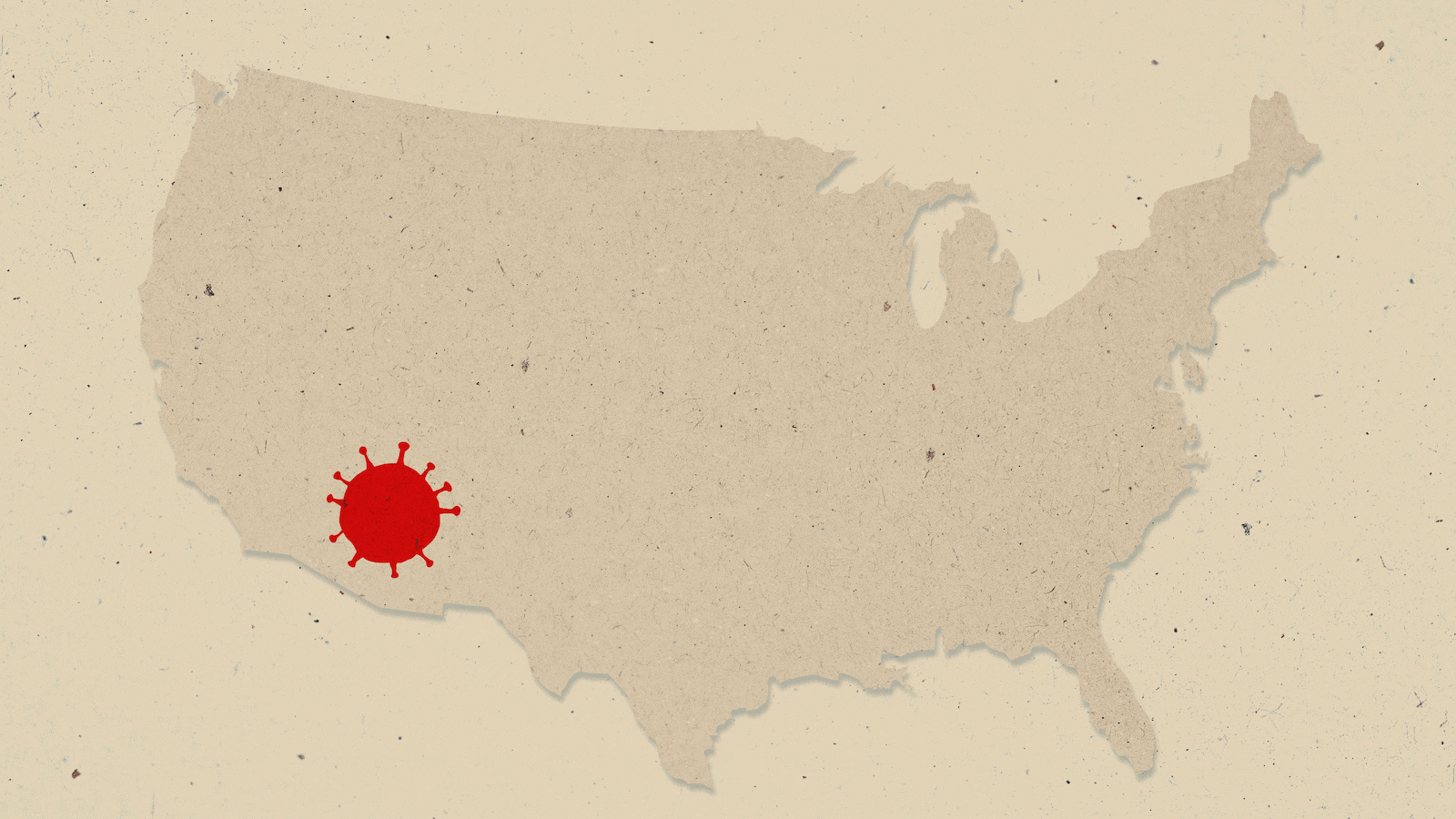“We’re at capacity.”
That’s how a nurse in Arizona who treats COVID-19 patients summed up the situation at her state’s facilities on Wednesday, describing 12-hour shifts treating more and more severely ill patients, many of whom have died.
“It’s exhausting and emotionally draining, and you feel helpless and just very sad for people,” the nurse, who requested anonymity for fear of professional retaliation, told The Daily Beast.
As of Wednesday afternoon, Arizona had at least 28,296 confirmed coronavirus cases and 1,706 deaths, according to the Johns Hopkins University Coronavirus Resource Center, which also showed a concerning upward trend. The state had 1,553 new cases on June 5, its highest daily peak for new cases since the pandemic began. According to a comparison of all 50 states, the Johns Hopkins data showed that Arizona had among the biggest upward case trends of any state in the U.S.
After the state’s largest hospital system warned on Monday that its intensive care units were quickly approaching capacity, state and national experts called the upward case trend so “alarming” as to raise the possibility of a second stay-at-home lockdown order, The Arizona Republic first reported.
If nothing else, the situation there seemed like one that might have been plucked out of New York City or another COVID hot zone months ago, rather than a state in the middle of reopening. It was especially remarkable given the state’s largely lauded initial lockdown, which experts said “had teeth” and appeared effective. At least until it ended.
From May 16 to Tuesday, June 9, COVID-19 cases increased by 108 percent, though testing increased by only 100 percent, and hospitalizations have steadily risen too, the Republic reported. The percentage of positive tests, which was at 5 percent one month ago, stood at 12 percent last week, the newspaper added. If testing capacity were solely responsible for the uptick, experts have said, those positive test percentages would be decreasing.
“We have seen a steady climb of COVID-19 cases in Arizona over the last two weeks,” Banner Health tweeted on Monday. On May 15, the state’s stay-at-home order ended. Since that date, according to the hospital, “ventilated COVID-19 patients have quadrupled.”
“This trend is concerning to us, and also correlates with a rise in cases that we are seeing in our hospital ICUs,” Banner Health wrote.
Days before those tweets, Dr. Cara Christ, the director of the Arizona Department of Health Services, sent a letter to Arizona hospitals on June 6, ordering them to “fully activate” any COVID-19 emergency plans to prepare for crisis care.
The nurse who was interviewed by The Daily Beast on Wednesday said she has already been—since the pandemic began months ago—diagnosed with the virus and quarantined at home. As for her hospital, she said, “We aren’t accepting any more COVID ICU patients, and we are at capacity with the ICU patients that we have.”
“We all felt this would be a possibility, and I’m concerned about it,” said the nurse, voicing a concern echoed by public health officials all over the state: whether any Arizona facility has what it needs to take care of the increasingly large population of patients.
“We’re going to run out of room to care for people, we’re going to run out of PPE, out of ICU beds, out of hospital beds, and we aren’t going to be able to provide care for the population of people who are going to need it,” she said, growing frustrated. “I don’t see people wearing masks. I don’t see people social distancing.”
A group of six Arizona hospital leaders representing 80 percent of the healthcare providers in the state issued a statement on Thursday, after this story was published, assuring the public “that we have available bed capacity and surge plans” in place “to continue to serve the people of Arizona.
“We are well prepared to manage an increase in patient volume,” said the statement. “Our surge plans will also create additional capacity for patients if needed. Arizona’s network of medical care is strong, stable and prepared.”
“We have taken every precaution to ensure the well-being of our patients and staff in our medical facilities,” the statement continued. “If you require medical attention, please do not delay seeking care for any medical conditions.”
Dr. Megan Jehn, a clinical epidemiologist and an associate professor of global health at Arizona State University, told The Daily Beast that the exponential growth in the state’s case numbers is evidence of an increase in community transmission. That is, it wasn’t just, as Gov. Doug Ducey has said, a result of increased testing capacity.
Jehn called the last few weeks’ numbers “particularly concerning.”
“Anecdotally, it’s easy to walk down busy streets and see people without masks,” Jehn told The Daily Beast. “We really need to emphasize a need for community responsibility.” At this point, she added, “It’s hard to say whether it’s messaging or noncompliance.”
And though public health experts initially lauded Ducey’s stay-at-home order—and the diligence with which civilians were following guidelines—its end on May 15 was seen, at least by Will Humble, the executive director of the Arizona Public Health Association, as “a light switch.”
Regardless of who might be at fault, the latest numbers are staggering.
More than 4,000 of Maricopa County’s 14,374 cumulative cases since the pandemic began are from just this month. The Maricopa County Health Department announced on Monday that the Phoenix area has seen a worrying spike of cases, warned that local hospitals were becoming increasingly overwhelmed, and cautioned anyone venturing out of their home to wear a mask if they’re unable to maintain social distance. Meanwhile, county officials tried to curb a dramatic 10-day increase in coronavirus cases—from six on May 30 to 203 on June 9—in local jails. In state prisons, the Arizona Department of Corrections reported 242 positive cases on Wednesday.
And the possibility of large-scale public congregation will only increase in the coming weeks, as President Trump told reporters on Wednesday that he will restart campaign rallies, including one in Arizona.
While Arizona has begun to stand out as a hot zone of national interest, it’s just one of up to 22 states seeing upward trends, including Alaska, California, Florida, Kentucky, Oregon, South Carolina, Tennessee, and Texas, according to CNN. Fourteen of those states have just this month recorded their highest seven-day average of new COVID-19 cases since the pandemic began.
Still, public health experts have called special attention to Arizona, along with Arkansas and Utah. On Monday, New York Gov. Andrew Cuomo called Arizona a “cautionary tale” for reopening too quickly without enough guidance to the general population.
Dating back to the early days of the pandemic, Arizona was among the first states in the U.S. to confirm a local case of the virus in January, after a member of the Arizona State University’s Tempe campus was diagnosed. But Arizona—at least for a while—escaped the fate of early hot zones, like New York and Seattle, which experienced massive infection, nearly overrun hospitals, and thousands of deaths. Now that those hot spots have begun to cool, the highest percentages of new cases are coming from places with much smaller populations, The Washington Post reports.
Earlier models used by the White House Coronavirus Task Force, like the one from The Institute for Health Metrics and Evaluation at the University of Washington, showed in mid-May that Arizona could reach about 2,900 deaths by Aug. 4. But that number has significantly shifted in recent weeks, and the model now predicts more than 4,400 deaths by that same date.
“Increased community spread is like a fire, with little embers everywhere,” said Jehn. “If we can’t control this, we’re going to see a rapid escalation of cases, of people potentially getting really sick. We need to act now to get ahead of this growth.”
“The priority has to be to get people to reduce contact, mask-wearing, and community responsibility,” she continued. “If not, a lockdown is maybe where we’re headed.”
Still, Jehn acknowledged that a secondary lockdown “just may not be acceptable to the community.”
That’s a valid concern, given that, as the the Phoenix New Times reported last month, at least two county sheriffs publicly declared their refusal to punish any business owners or arrest any individuals for violating the state’s lockdown order. Pinal County Sheriff Mark Lamb and Mohave County Sheriff Douglas Schuster, neither of whom returned requests for comment from The Daily Beast on Wednesday, said they would “educate and advise” owners about the governor’s executive order but that they would not enforce it.
“I’m not trying to change his policy, I’m just disagreeing with it, and I won’t enforce it,” said Lamb on May 1. “I don't think it's right.”
What’s more, when reached on Wednesday by The Daily Beast, Patrick Ptak, a spokesman for Gov. Ducey, flatly denied that Arizona was considering going back into lockdown. Ptak repeated earlier talking points from the governor, cited at length elsewhere: that an increase in testing was inevitably going to increase the number of positive cases. Testing in the state, said Ptak, has doubled since the stay-at-home order ended on May 15. A spokesperson for the Arizona Department of Health Services did not respond to a request for comment.
“We have anticipated increased cases in June based on various modeling, including the projections in a model provided by FEMA, and we’ve spent the last few months working to increase capacity to ensure every Arizonan has access to care, should they need it,” said Ptak. “Alternate care sites are ready for activation if and when we need additional capacity, something that is not necessary at this time. We’ve continued to focus on protecting our most vulnerable, including those in nursing homes and long-term care settings.”
“We’re also working with public health officials and leaders in the business, education, and nonprofit communities and more to provide guidance, ensuring businesses return smarter and work to mitigate the spread,” Ptak added.
Others were not so certain of the governor’s response to the crisis after the lockdown ended.
In the beginning, Arizona “had a really good stay-at-home order that people complied with,” said Humble, from the Arizona Public Health Association, a nearly century-old nonprofit that has helped shape public health in the state. “It had teeth in it, and Arizonans did a good job.” But the order ended on May 15, and then Memorial Day weekend provided the opportunity for residents to socialize, drink, and attend nightclubs, he said.
“By May 26, there was a consistent increase in all 15 counties, and that trend was remarkable—it looks like a checkmark,” he continued. “Cases were declining, then the stay-at-home order ended, and they shot up.”
“From a big picture perspective, all the sacrifice we’ve made as a state and as individuals has been squandered,” Humble added.
When mulling over those numbers, the 60-year-old former Arizona state health director’s biggest fear wasn’t just the community at large. It was his son.
The past several weeks of rapidly increasing case counts and concerning hospitalizations has stoked Humble’s anxiety that his 26-year-old son Luke, who has Down syndrome, might get sick and be hospitalized, without any visitors allowed.
“He’s good at texting, but Luke would not understand why we weren’t there,” said Humble. “I think he would survive, but it would be torture knowing he’s in a hospital and we couldn’t be there.”
Humble’s story highlights that the oft-repeated—and sometimes prosaic—pleas for diligence from public health experts are still based on something nearly all Americans can relate to: family.
Ultimately, said Humble, all Arizonans should be thinking about their most vulnerable family members, because right now, “every indicator across the dashboard is blinking.”
“It’s like Katrina,” he explained. “There’s a big hurricane spinning out in the Gulf, and forecast models are showing it’s going to come to shore. But today? It’s a great day, and it’s sunny outside, and we’re going to just enjoy it.”
But make no mistake, said Humble: “There’s a storm brewing.”






